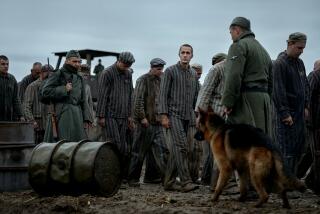WEEKEND TV : HAUNTING HOLOCAUST IMAGES VIA ART
- Share via
There are no pictures of gas chambers or ghastly heaps of bodies in “The Children of Terezin.” Yet Eytan Keller’s moving documentary (Sunday afternoon at 4:30 on Channel 2) contains some of the most powerful images of the Holocaust you’re ever likely to see.
Terezin was--and still is--a quaint 18th-Century Czech fortress town near Prague. During World War II it became the so-called “Paradise Ghetto” and was used by the German propaganda machine to try to show that the relocation of Europe’s Jews did not mean their liquidation.
Hitler’s showplace ghetto, however, was actually a way station to the extermination camps. Behind the town’s picturesque post card facade 65,000 people were crammed into barracks and attics and cellars.
Altogether, 140,000 souls passed through Terezin--15,000 of them children. While they were there, however, they managed as best they could to resist their captors--not with guns or violence, but with art. At night in their secret schoolrooms in attics and cellars, the children and their art teachers systematically documented the true horror of their daily lives by drawing thousands of artworks that were hidden and saved.
Keller is a producer/director of variety and comedy shows who spent five years making “Children.” He found 20 of the 100 children of Terezin who survived the war and their only living teacher, and he was able to gain entrance to the attic of the Prague Jewish Museum to duplicate 2,000 watercolors and charcoal drawings from Terezin.
Keller uses these haunting artworks--as well as poems and music composed at Terezin--to illustrate the survivors’ painful remembrances. He mixes them skillfully and effectively with never-before-seen German propaganda film, stark black-and-white stills, old family photos, official identification cards and contemporary footage.
As narrator Leonard Nimoy concludes, the defiant legacy of the children of Terezin shows that man’s creative energies cannot be stifled by incarceration. That legacy, like Keller’s fine work (which he apparently never intended for broadcast), “warns us of the consequences of indifference and silence when faced with the truth of man’s inhumanity to man.”
More to Read
The biggest entertainment stories
Get our big stories about Hollywood, film, television, music, arts, culture and more right in your inbox as soon as they publish.
You may occasionally receive promotional content from the Los Angeles Times.










